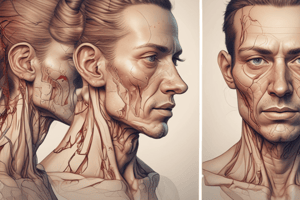Podcast
Questions and Answers
Bleeding from soft-tissue injuries to the face is MOST effectively controlled with:
Bleeding from soft-tissue injuries to the face is MOST effectively controlled with:
- Direct pressure using dry, sterile dressings. (correct)
- Pressure dressings and chemical ice packs.
- Digital pressure to an adjacent pulse point.
- Ice packs and elevation of the patient's head.
Facial injuries should be identified and treated as soon as possible because:
Facial injuries should be identified and treated as soon as possible because:
- Of the risk for airway problems. (correct)
- The spine might be injured as well.
- Bleeding must be controlled early.
- Swelling might mask hidden injuries.
Frequent reassessments of the patient with face or neck injuries are MOST important because:
Frequent reassessments of the patient with face or neck injuries are MOST important because:
- Hospital staff require frequent patient updates.
- Such injuries can affect the respiratory system. (correct)
- They lend credibility to your documentation.
- Rapid facial swelling might mask hidden injuries.
The Adam's apple is:
The Adam's apple is:
The conjunctiva are kept moist by fluid produced by the:
The conjunctiva are kept moist by fluid produced by the:
The cricoid cartilage:
The cricoid cartilage:
The eyeball itself is referred to as the:
The eyeball itself is referred to as the:
The inner surface of the eyelids and the exposed surface of the eye itself are covered by a delicate membrane called the:
The inner surface of the eyelids and the exposed surface of the eye itself are covered by a delicate membrane called the:
The lower jawbone is called the:
The lower jawbone is called the:
The mastoid process is located approximately:
The mastoid process is located approximately:
The skin and underlying tissues of the face:
The skin and underlying tissues of the face:
The small, rounded, fleshy bulge immediately anterior to the ear canal is called the:
The small, rounded, fleshy bulge immediately anterior to the ear canal is called the:
The superior temporal artery can be palpated:
The superior temporal artery can be palpated:
The term 'hyphema' is defined as:
The term 'hyphema' is defined as:
The upper jawbones are called the:
The upper jawbones are called the:
The white portion of the eye is called the:
The white portion of the eye is called the:
What is the function of the sternocleidomastoid muscle?
What is the function of the sternocleidomastoid muscle?
When a light is shone into the pupil:
When a light is shone into the pupil:
When transporting a patient with a facial injury, it is MOST important to be as descriptive as possible with the hospital regarding the patient's injuries because:
When transporting a patient with a facial injury, it is MOST important to be as descriptive as possible with the hospital regarding the patient's injuries because:
Which of the following findings would be LEAST suggestive of a head injury?
Which of the following findings would be LEAST suggestive of a head injury?
Flashcards are hidden until you start studying
Study Notes
Face and Neck Injuries Overview
- Bleeding from facial soft-tissue injuries is best controlled with direct pressure using dry, sterile dressings.
- Prompt identification and treatment of facial injuries are essential due to potential airway obstruction risks.
Patient Assessment
- Frequent reassessments are vital as facial and neck injuries can compromise the respiratory system.
- Descriptive communication with the hospital can facilitate necessary specialist consultations for facial trauma cases.
Anatomy Focus
- The Adam's apple is the upper part of the larynx formed by the thyroid cartilage.
- The cricoid cartilage is the only complete circular cartilage of the trachea, located below the thyroid cartilage.
- The lower jawbone is known as the mandible, while the upper jawbones are called maxillae.
Eye and Eyelid Structure
- The globe refers to the eyeball itself, while the conjunctiva is the delicate membrane covering the inner eyelids and eye surface.
- The lacrimal gland keeps the conjunctiva moist.
- A hyphema is a condition characterized by blood in the anterior chamber of the eye.
Musculoskeletal Anatomy
- The sternocleidomastoid muscle allows movement of the head.
- The mastoid process can be palpated approximately one inch posterior to the external ear opening.
Important Physical Responses
- The pupil should constrict when light is shone into it; failure to do so can indicate injury.
- Briskly constricting pupils in response to light is least suggestive of head injury.
Common Injury Indicators
- Rapid swelling can hide underlying injuries, making it critical to monitor facial conditions closely.
- Facial injuries often lead to significant bleeding due to the vascular nature of facial tissues.
Additional Anatomical Features
- The tragus is the small rounded bulge located anterior to the ear canal.
- The sclera is the white outer part of the eye, contrasting with the cornea and iris.
Studying That Suits You
Use AI to generate personalized quizzes and flashcards to suit your learning preferences.




